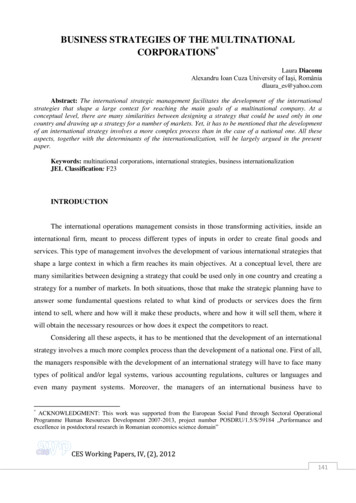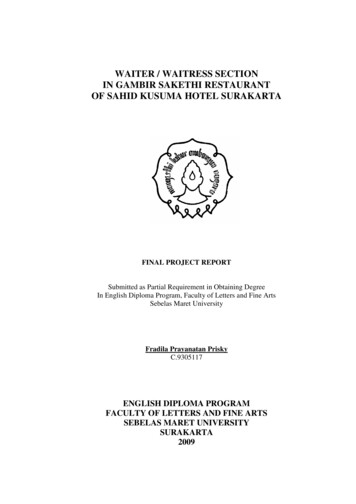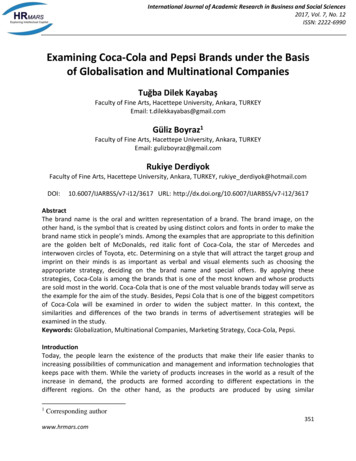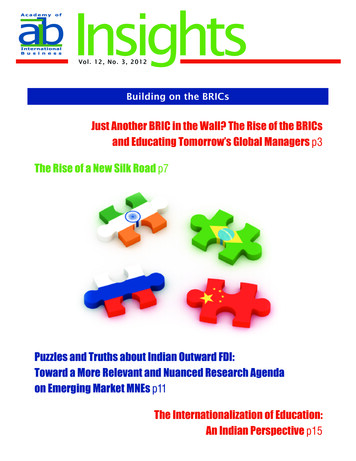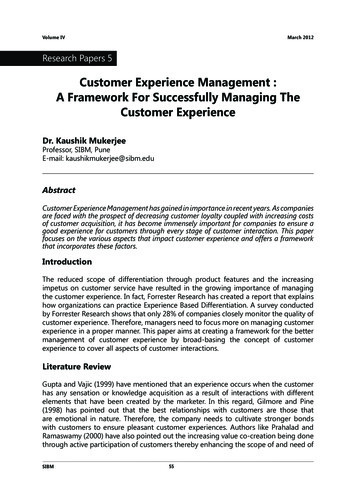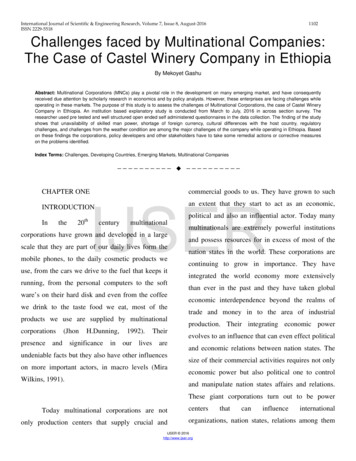
Transcription
International Journal of Scientific & Engineering Research, Volume 7, Issue 8, August-2016ISSN 2229-55181102Challenges faced by Multinational Companies:The Case of Castel Winery Company in EthiopiaBy Mekoyet GashuAbstract: Multinational Corporations (MNCs) play a pivotal role in the development on many emerging market, and have consequentlyreceived due attention by scholarly research in economics and by policy analysts. However, these enterprises are facing challenges whileoperating in these markets. The purpose of this study is to assess the challenges of Multinational Corporations, the case of Castel WineryCompany in Ethiopia. An institution based explanatory study is conducted from March to July, 2016 in across section survey. Theresearcher used pre tested and well structured open ended self administered questionnaires in the data collection. The finding of the studyshows that unavailability of skilled man power, shortage of foreign currency, cultural differences with the host country, regulatorychallenges, and challenges from the weather condition are among the major challenges of the company while operating in Ethiopia. Basedon these findings the corporations, policy developers and other stakeholders have to take some remedial actions or corrective measureson the problems identified.Index Terms: Challenges, Developing Countries, Emerging Markets, Multinational Companies—————————— ——————————IJSERCHAPTER ONEcommercial goods to us. They have grown to suchINTRODUCTIONan extent that they start to act as an economic,Inthe20thpolitical and also an influential actor. Today manycenturymultinationalcorporations have grown and developed in a largescale that they are part of our daily lives form themobile phones, to the daily cosmetic products weuse, from the cars we drive to the fuel that keeps itrunning, from the personal computers to the software’s on their hard disk and even from the coffeewe drink to the taste food we eat, most of theproducts we use are supplied by ,significancein1992).ourTheirlives areundeniable facts but they also have other influenceson more important actors, in macro levels (MiraWilkins, 1991).multinationals are extremely powerful institutionsand possess resources for in excess of most of thenation states in the world. These corporations arecontinuing to grow in importance. They haveintegrated the world economy more extensivelythan ever in the past and they have taken globaleconomic interdependence beyond the realms oftrade and money in to the area of industrialproduction. Their integrating economic powerevolves to an influence that can even effect politicaland economic relations between nation states. Thesize of their commercial activities requires not onlyeconomic power but also political one to controland manipulate nation states affairs and relations.These giant corporations turn out to be powerToday multinational corporations are notonly production centers that supply crucial ns, nation states, relations among themIJSER 2016http://www.ijser.org
International Journal of Scientific & Engineering Research, Volume 7, Issue 8, August-2016ISSN 2229-55181103and domestic affairs of their own home countriesreduction thereby enhancing a better standard of(Mira Wilkins, 1991).life. According to the sources of US Department ofState on Investment Climate of Ethiopia by 2015the competitive labor and energy costs as well asMultinationalcorporationsoperatingindeveloping countries should not forget that thesemarkets are highly unpredictable, unstable and lessprofitable. Whether they are domestic or foreign,Multinational corporations (MNCs) operating inemerging markets face a variety of complex andmultifaceted challenges. The real challenge forMNCs is to achieve sustainable growth andprofitability in these emerging markets whilethe budding consumer markets are key pulls forforeign direct investment (FDI). The ortunities to operate in Ethiopia are not withoutchallenges (US Department of State, 2015). Basedon the above fact this particular research tries toassess the challenges of a Castel Winery Factoryone of the multinational companies in the countrywhile operating in Ethiopia.contributing explicitly and consistently to theIJSERoverall well being of human being (Ayub1.1 Statement of the ProblemMohammed, 2015).MultinationalCompanieswhichareoperating in emerging markets have better chancesto establish, grow and sustain since the markets inComing to the Ethiopian perspective c reforms have been implementedwith the objective of achieving croeconomic reforms include privatization ofstate owned enterprises, liberalization of tradepolicy, reduction of import tariff rates, eliminationof non-tariff barriers, devaluation and deregulationof price and exchange rate controls ,investmentpolicy reviews, industrial promotion, privatizationprograms, creation of smooth dispute settlementmechanisms, investment incentives(US Departmentof State,2015). These reforms have also beenimplemented with the aim of attracting foreignthese countries are getting stronger and better yearafter a year. That being said MultinationalCompanies should not forget that these markets arehighly unpredictable, unstable and less profitable.Whether they are domestic or foreign, markets face a variety of complex and multifacetedchallenges. These challenges range from companyspecific, to country specific and global es for Multinational Companies is toachieve sustainable growth and profitability in theseemerging markets while contributing explicitly andconsistently to the overall well being of the humanbeing.direct investment to the ultimate goal of povertyIJSER 2016http://www.ijser.org
International Journal of Scientific & Engineering Research, Volume 7, Issue 8, August-2016ISSN 2229-5518Comingtoperspective,(UNCTAD), states that the FDI inflow to thealthough it is one of the countries with the fastestcountry had reached 953 million dollars in 2014, upgrowing economy, still there is a persisting povertyfrom the 279 million dollars it was in the previousand unemployment both in rural and urban areasyear. Its foreign direct investment inward stock also(MOFED,isreached close to 6.1 billion dollars in 2013, up fromundertaking the growth and transformation plan941 million dollars in 2012.Though the amount ofwhich is a robust plan acquiring significant capitalFDI inflow in the form of merger and acquisitioninvestment and technology transfer.has increased a considerable amount in the year, r, due to the low saving of thecountry there is financial inadequacy constraining inmajor part of the countries investment inflow comesfrom Greenfield projects, according to the report.achieving development goals. The governmentrecognizes the role of private investment inparticular foreign direct investment to fill the gap ofAs a study conducted by Delhi University,Department of East Asian Studies in 2015,IJSERthe capital constraint and revised the investmentproclamations several times. It also revised theinvestment proclamations several times and openedeconomic sectors to foreign investors with fewrestrictions. The government has also issued severalinvestment incentives, including tax holidays, dutyfree import of capital goods and export taxexemptiontoencourageforeigninvestment(MOFED, 2012).Multinational companies (MNCs) are gettingwidely to the boarders of Ethiopia thinking thefavorable conditions on its geographical location,strong economic trends, political stability, keennesson government part, change and trainable labor, itsfavorability as the starting point for greaterengagement with Africa, tremendous potential as anew markets for its products launch pad forinternational markets, its strengthening solidaritywith African nations etc. According to the reportsThe world Investment Report released onof the UNCTAD by 2014, with in the continuingJune 24, revealed that Ethiopia was the third largestsignificant increase of the inflow in the same year,recipient of foreign direct investment (FDI) inthe robust economic growth and the growing middleAfrica in 2013, with a 20pc increase from theclassamount in 2012.The country has also registered aattractiveness of Ethiopia as a preferred destinationsignificantDirectof cross boarder investors and MultinationalInvestment (FDI) stock-the amount of investmentCompanies. Even with these favorable conditionswithin the economy. The report by the UnitedMultinational Companies operating in the countryincreaseintheirForeignNations Conference on Trade and DevelopmentIJSER othe
International Journal of Scientific & Engineering Research, Volume 7, Issue 8, August-2016ISSN 2229-55181105are facing grievances and challenges (Prateeksha,Tiwari, 2015).1.2.2. Specific ObjectivesThis particular research is of special interestto assess the challenges of MNCs operating inTo identify the challenges of the CastelWinery Company while operating in Ethiopia.Ethiopia, the case on the Castel Winery Company,To investigate the efforts of the CastelFrench originated multinational company situated atZeway town. In line with the above statement of theproblems this research tries to answer the followingWinery Company in order to achieve sustainablegrowth and profitability.To suggest some policy recommendations.questions:What are the challenges Castel Winery1.2.3. Scope of the StudyFactory is facing while operating in Ethiopia?IJSERBoth the theoretical aspect andHow the Castel Winery Company tacklesempirical evidence show that MNCs ischallenges it faces while operating in Ethiopia?What are the contributions of the MNCs(The Castel Winery Company) in the developmentof the country?wider in concepts and in application that canbe dealt both with macro level and microlevel issues. However this research islimitedWhatare theimplicationsandpossible lessons that could be atcorporationsdeveloping markets with a special emphasis1.2 Objectives of the studyon the Castel winery company, situated atZeway town. The research basically relieson1.2.1 General Objectivesliteraturesonthesubjectarea,publications and data by the EthiopianMinistry of Trade, questionnaires andThis research paper tries to assess theinterviews collected from managers andchallenges multinational corporations are facingexperts of the Castel Winey Company andwhile operating in developing markets based on theother Publications and sources on the subjectcase study conducted on Castel Winery Factory inmatter.Ethiopia.1.2.4. Significance of the StudyIJSER 2016http://www.ijser.org
International Journal of Scientific & Engineering Research, Volume 7, Issue 8, August-2016ISSN 2229-55181106The research has the following significancesfor parties who have direct or indirect interest on it;Furthermore some of the respondents wereunwilling to give information due to lack of timeThe output from the research canand other reasons. Since the research is conductedhelp corporations, policy developers andon a single multinational company, it did not coverother stakeholders to take some remedialall the operational challenges of multinationalactions or corrective measures on thecompaniesproblems identified in the research;researcher believes that this gap will pave the wayIt enables the researcher to acquirethroughoutthecountry,andthefor other researcher to go through on the area.basic experiences regarding several andMultinationalatmethodsdevelopingofThe first Chapter deals with the introduction andIJSERprovided by the researcher can also enablethe interested parties to solve the identifiedbackground, the objectives, significance, scope andlimitations of the study are stated. The secondchapterproblems;It also serves as a future referencefor researchers on the area. In addition thisresearch will point and raise the commonchallenges and efforts of tackling challengestheThe paper is organized in to five chapters.tacklingchallenges, and the tentative solutionsof1.6 The Organization of the cal literatures. The methodology, datasources and method of collection, sample size andsampling techniques are included in chapter three.Chapter four provides data presentations andanalysis and the last chapter wraps up the thesis ns.developing countries.1.5 Limitations of the studyAs researches conducted so far on MNCs inEthiopia are limited, the study is constrained by theCHAPTER TWOavailability of empirical literature. Pertaining to theReview of Literaturenature of the employees of the company there werefear and reservations in revealing all necessary1.2MNCsinformation regarding the challenges their companyis facing while operating its activities.IJSER 2016http://www.ijser.orgDefinition and Theoretical Context of
International Journal of Scientific & Engineering Research, Volume 7, Issue 8, August-2016ISSN 2229-5518ththIn the late of 19 and early 20 centuries,1107Atthispoint,adefinitionofthethe world shrank in its physical dimensions, asMultinational Corporation should be made to claritysteamships,reducedthe conceptual framework, a company that has itsdistances. Throughout the whole world economichead quarter in one country (which is the homeconditions changed. This was the time of substantialcountry), and which operates in at least one foreigntechnological advance with new products, processes(host) country (Mira Wilkins 1991). Multinationaland forms of business organizations challenging thecorporations are profit seeking organizations thatold order (Mira Wilkins, 1991). Developments inhave activities in more than one country with ancommunication and transportation had varyingaim to expand sales, to acquire resources, toconsequences in different areas of life. The actors indiversify sources of sales and supplies and tothe international political and economic arenaminimize competitive risk.telegraphsandcablesstarted to change in order to adapt themselves tothese new circumstances. During the 20th centuryMultinational corporations do not just meanIJSERstates become more cooperative with the ons. The private sector modified itselfwith the introduction of new institutions in order tokeep itself in step with the developments intechnology. It is believed that “MultinationalCorporations” emerged from this atmosphere as oneWestern or Japanese MNCs but also a growingnumber of MNCs from emerging economies inAsia, Africa, and Latin America (Zhang, 2008).Other equivalent terms used for an MNC areMultinationalEnterprises(MNEs)oranInternational Corporation. A company or anyoverseas ventures are not considered MNCs unlessof the leading actors.theyCompanies from Britain, the United States,havesubstantialinvestmentinforeigncountries and actively manage those operations andcontinental Europe, Japan and Canada extendedregard those operations as integral parts of thetheir activities overseas by making foreign directcompany both strategically and organizationallyinvestments and controlling some production(Bartlett and Ghoshal,1998). Traditionally, theactivities from their home based headquarters (Miraheadquarter (HQ) or the corporate office of anWilkins, 1991). International trade, which is a partMNC is located in the home country or the parentof the world economy, gained a new dimensioncountry of the company and its subsidiaries arewith the emergence of the multinational d in foreign countries (host countries).ofinternational trade by adding new concepts like2.2‘Foreign Direct Investment,’ Joint Ventures’ and‘overseas operations.MarketsIJSER 2016http://www.ijser.orgMeanings of Emerging /Developing
International Journal of Scientific & Engineering Research, Volume 7, Issue 8, August-2016ISSN 2229-55181108countries’ sources of cheap raw materials and laborThere is no one definition of the term“Emerging Market”.rather than their markets (Arnold and Quelch,1998).Some writers call theseEmerging markets denote countries andmarkets as developing markets or countries sincemarkets playing catch-up: nations with an undertheir growth is fast, high and stable. Arnold anddeveloped industrial base and infrastructure on theQuelch (1998) suggest few aspects which high lightone hand, but a rapid rate of growth (usuallythe characteristics of an emerging market:exceeding that of developed nations) on the otherEconomicdevelopmentbasedonthehand. In addition, emerging markets are oftendistinguished by some level of political andaverage GDP per capita.institutional instability, and ongoing demographicThe relative pace of economic development,usually indicated by the GDP growth rate.growth (Guillen and Garcia-Canal, 2013). Thoseeconomics outside of the developed world-US,Third is the system of market governanceCanada, Japan and Europe are what are commonlyIJSERand, in particular, the extent and stability of a free-referred to as the emerging market (Guarino, 2010).market system.Fan (2008) suggests that emerging market is a termAn emerging market is also described aswhich refers to a country that has undertaken“society transitioning from a dictatorship to a freetransition in its political or economic systems andmarket – oriented economy, with increasingexperienced rapid economic development.economic freedom, gradual integration with in theglobal market place, an expanding middle class,2.3MNCs Impacts on Host DevelopingCountriesimproving standards of living and social stability2.3.1 Economic Impacts of MNCsand tolerance, as well as an increase in corporationswith multinational institutions (Van de Kuil,Since Caves (1974) original contribution,2008)”. Emerging markets economies refers toempirical assessment of the impact of FDI on hostthose countries that are starting to participatecountries has proliferated in the economic literature.globally by implementing reform programs and areIn relation to the impacts of FDI on host developingundergoing economic improvement (Zhang, 2008).countries, economists have identified at least threeThe phrase “emerging markets” is being adopted inways that local firms and employees can beplace of the previous lexicon of” less developedadvantaged (or disadvantaged) by the presence ofcountries,” newly industrializing countries, or evenMNCs, through wage spillovers, export spillovers,Third World Countries, which emphasized theand/or productivity spillovers. Wage spilloversoccur because MNCs tend to pay higher wages andoffer better job opportunities than the domesticIJSER 2016http://www.ijser.org
International Journal of Scientific & Engineering Research, Volume 7, Issue 8, August-2016ISSN 2229-55181109firms in developing countries (Morrissey and Tedevelopment trajectories (Narula and Driffield,Velde, 2003); Positive wage spillovers occur when2012). Based on the assumption that MNCs Possessthe higher wages paid by foreign firms produce andsuperior technological capabilities compared toincrease in the wages paid by domestic firms,domestic firms in developing countries, scholarswhich, because they compete for human resourcestraditionally have analyzed them in relation theirare forced to offer similar or better workingbeingconditions to foreign firms, in order to attract andaccumulation of new technological capabilities byretain the best workers. Conversely, negative wagedomestic firms via MNCs, in turn, contributes tospillovers occur when the presence of MNCs leadstheir increased productivity. Qualitative researchto a reduction in the wages paid by domestic firms,shows that productivity spillovers take variousoften as a result of the foreign firms poaching theforms. Domestic firms can become more efficientbest (and hence most expensive) workers fromand thus more competitive as the result of thedomestic firms the labor market crowding andalsoThethroughIJSEReffect.imitation, based on employing managers trained byA second way that MNCs can have aneconomic impact on host developing countries isMNCs (labor mobility) or direct collaboration witha foreign firm.through export spillovers. Central to this is the ideaThe evidence on productivity spilloversthat domestic firms in developing countries cangenerated by MNCs in developing countries islearn about exporting because MNCs generallygenerally inconclusive. Some econometric studiespossess good commercial skills, which domesticfind evidence of positive spillovers for domesticfirms in host countries lack.firms (kokko, 1994). However, several studies findorinsignificant or negative spillovers. Evidence ofimitation allow domestic firms to learn how to enternegative spillovers points to the possibility thatexport markets (Gorg and Greenaway, 2004) and todomestic firms reduce their productivity as aincrease their exporting activities. The empiricalconsequence of shrinking market shares (Aitken andliterature on export spillovers in host developingHarrison, 1999). There is also work that findscountries is also mixed (Anwar and Nguyen, 2011).differences in horizontal spillovers to domesticCommerciallinkages,collaborationfirms in the same sector as the MNC, and verticalspillovers, which refer to the productivity gainsFinally, MNCs can have an impact as aresult of technological and productivity spill overs,achieved by domestic firms in upstream ordownstream sectors (Quoc Le and Pomfret,2011).which are considered to be important sources ofeconomic advantage for host countries’ long termIJSER 2016http://www.ijser.org
International Journal of Scientific & Engineering Research, Volume 7, Issue 8, August-2016ISSN 2229-5518On the basis of this very mixed evidence,1110of poor countries through the adoption of voluntaryscholars warn that, although the current policycodesliterature is overflowing with claims of positiveResponsibility (CSR) policies (Falck and Heblic,spillovers from FDI, evidence of their existence is2007). Alongside this, there is a growing awarenessless profuse (Rodrik, 1999; Gog and Greenaway,among MNCs executives that respect for human2004).rights is a fundamental and necessary part of theofconductandCorporateSocialpractice of good management (Brown and Woods,2007). CSR policies and the adoption of ethicalcodes of conduct address human right issues inseveralSimilarly to the case of MNCs economicimpacts, there is no consensus in the academicinstance,throughgreaterallow firms to play a significant role in promotingdifferent kinds of civil, political, and socio-IJSERresearch on FDI and the human rights cause. Debateon the impact of MNCs on society and, moreonForinvestment in addressing unfulfilled societal needs,2.3.2 Human Rights Impacts of ersy involving both optimistic voices andcritical ones. Optimistic views are generally from aliberal political science perspective (Harrelson-Stephens and Callaway,2003) and rely on the ideathat MNCs are powerful and wealthy actors that areable to contribute to increased GDP levels, greatereconomic rights, such as the right not to bediscriminated against, and the right to education andhealth, and a safe environment, etc. (Rivoli andWaddock, 2011). MNCs are also considered to becritical for minimizing the harmful impacts andactively contributing to peace building processes inconflict or post-conflict zones, through the adoptionof conflict sensitive CSR policy frameworks(Nelson, 2000, Banfield et al, 2003).respect for human rights, and democratization, andsuggest that multinationals may contribute toadvancing the cause of human rights because theybring”capital,technologies,2.4to introduce social improvement alongside theirfinancial investment” (Spar,1999:75). Among theoptimistic voices is also a community of scholars,practitioners and policy makers who believe thatlarge corporations can improve the living hniques and managers who frequently are eagerChallengesMNCs operating in emerging / developingmarkets have good chances to establish, grow andsustain since these markets are getting stronger andbetter year after year. That being said MNCs etsandlessarehighlyprofitable.Understanding diverse contemporary challengesIJSER 2016http://www.ijser.org
International Journal of Scientific & Engineering Research, Volume 7, Issue 8, August-2016ISSN 2229-55181111facing MNCs will make them more comfortable andcompanies can use cultural nuances as an advantagestable in these markets. Some of the challenges arewhen positioning the products internationallydescribed below.(Kotler et al., 2008). Dupriez and Simons (2000cited in Holden, 2002) state that companies thattake advantage of the diverse experience from themulticultural work environment, enjoy a wider and2.4.1 Socio-cultural Environmenthave a more open platform for addressingSocial organization, religion, customs andchallenges.rituals, values and attitudes and language are all2.4.2 Legal environmentdimensions of culture (Kotler et al.). Socialenvironment has a deep effect on a business. Theculture, cost structure, ideological characteristics,religion, customs and social conditions influence aCompanies should consider, when operatingin other countries that they operate not only byhome country rules but also by the host country andinternational laws (Doole and Lowe, 2004). ThisIJSERcustomer’s perceptions and also their buyingbehavior (Bensoussan and Fleisher, 2008). Thisfactor is a kind of value system of a society. Theway that goods or services are produced andintroduced to the society and the way that customersuse these products are completely influenced byattitude, customs and by culture (Doole and Lowe,2004)means that the country should have a flexibility andadaptability with law and other legal rules in t in each country that a company wantsto operate in is externally important (Doole andLowe, 2004). The legal system, by incorporatingprocedure and institution, provide ensuring orderfor tax economic output as well as commercialThere are several different factors that canactivities and also protect companies’ assetsaffect societies; however cultural differences, more(Cavusgil, knight, 2012). The domestic policies andthan any other factors, have influenced societies onalso market conditions are not the only factors thatthe basis of and language (Cavusgil, Knight, 2008).haveThis element can affect a person’s behavior as welldevelopments;as their opinion (Cavusgil, Knight, 2008).international economics and policies affect theIt is important for companies that theiremployees have knowledge about their cultures theconomicdomesticdevelopmentsand(Cavusgil,Knight, 2012).learn about the important aspects of the host countryThe countries’ laws and regulations canbefore settling a subsidiary there (Kotler et al.,increase the countries risks as well. If the foreign2008). By understanding the countries norms,companiesIJSER an
International Journal of Scientific & Engineering Research, Volume 7, Issue 8, August-2016ISSN 2229-55181112unfavorable for investing or if they realize that theproducts and service needs, and the incomelegal system is inadequate, they will not be willingdistribution (Kotler et al., 2008)to operate in that market. (Cavusgil, Knight andRisen Berger, 2012)There are four types of industrial structurethat need to be considered. The first one is thesubsistence economies where the vast majority isengaged in simple agriculture. They consume most2.4.3 Economic Environmentof their output and offer market opportunities.Economic environment includes the natureof the economic system, the economic policies ofThe second type is Raw-material exportingthe government, rate of inflation, interest rate andeconomies, these types of economics are verybusiness cycle (Benoussan and Fleisher, 2008).productive in one or more natural resources, but areCompanies need to, before entering a new market,penurious in other ways. These markets arebe informed of the country’s economic policies andbeneficial for products such as, large equipment,which market is developing. According to thistools and trucks. However, if there is a wealthyinformation, a company decides if they can competeupper class and a lot of foreign residents, the marketwith other companies in the market and gain profitcan be beneficial for luxury goods (Kotler et al.,in this market. Indeed, if they want to receive a2008). The third type is the industrializingmaximum of benefits, they should know about theeconomies where the manufacturing stands for 10 tomarket situation and make it ready for their product20 percent of the country’s economy. It is typical(Doole and Lowe, 2004).for industrialization economies to create a new richIJSERclass and growing but small middle class, who bothInternational marketers are required to s (Kotler et.al. es for raw materials and semi-finishedintegration, at a country level, a market level and atgoods. This is a rich market due to their largea world level which regards the world tradingmiddle class and the various manufacturinginfrastructureactivities (Kotler et al., 2008).theregionaland inve
1.2 Objectives of the study 1.2.1 General Objectives This research paper tries to assess the challenges multinational corporations are facing while operating in developing markets based on the case study conducted on Castel Winery Factory in Ethiopia. 1.2.2. Spe

